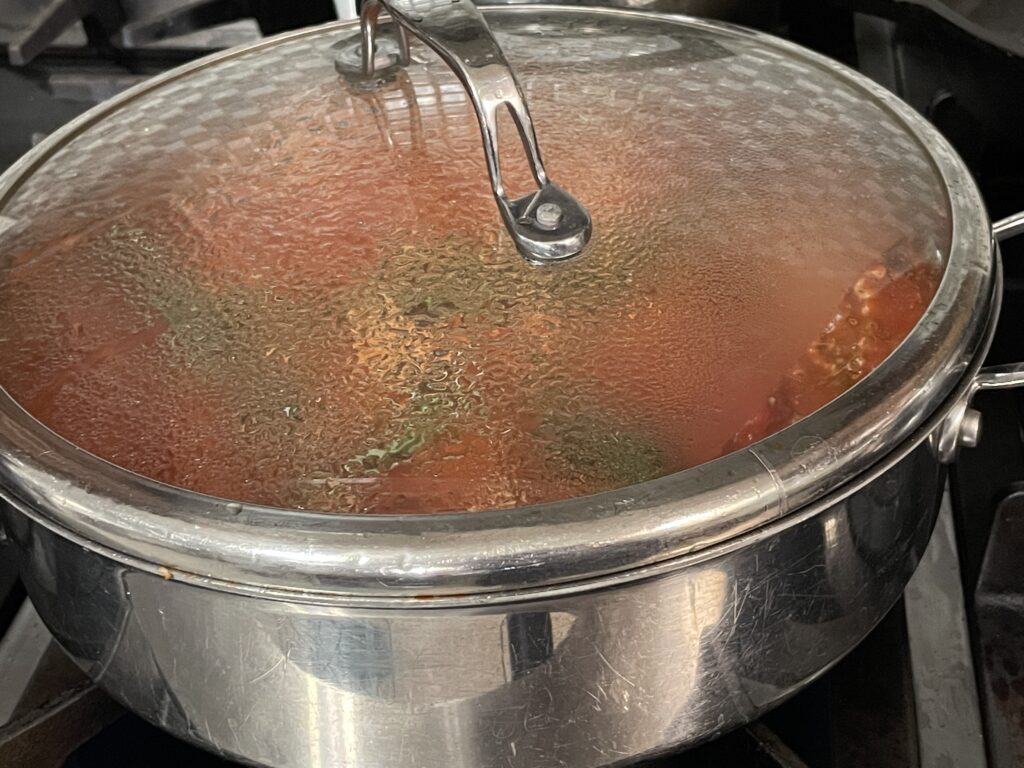Bolognese sauce, known in Italian as ragù alla bolognese or simply ragù, is a meat-based sauce in Italian cuisine, typical of the city of Bologna. It is customarily used to dress tagliatelle al ragù and to prepare lasagne alla bolognese. I was lucky enough to try this in Imola, Italy, decades ago, and there is no experience like it. You really do get to know a country through its food. And I will probably mention that statement many times. I truly believe it.
According to Lynne Rossetto Kasper’s book, The Splendid Table, the earliest documented recipe for a ragù served with pasta comes from late 18th century Imola, near Bologna, from Alberto Alvisi, cook of the local Cardinal Barnaba Chiaramonti, later Pope Pius VII.
Genuine ragù alla bolognese is a slowly cooked meat-based sauce, and its preparation involves several techniques, including appasire (sweating), sautéing and braising. Ingredients include a characteristic soffritto (onion, celery and carrot), and different types of minced or finely chopped beef, often alongside small amounts of fatty pork. White wine, milk, and a small amount of tomato paste or tomatoes are added, and the dish is then gently simmered at length to produce a thick sauce.

In the 19th century, Pellegrino Artusi published a recipe for a ragù characterized as bolognese in his cookbook. Artusi’s recipe, which he called Maccheroni alla bolognese, is thought to derive from the mid 19th century when he spent considerable time in Bologna. The sauce called for predominantly lean veal filet along with pancetta, butter, onion, and carrot. The meats and vegetables were to be finely minced, cooked with butter until the meats browned, then covered and cooked with broth. No tomato sauce was foreseen. Artusi commented that the taste could be made even more pleasant by adding small pieces of dried mushroom, a few slices of truffle, or chicken liver cooked with the meat and diced. As a final touch, he also suggested adding half a glass of cream to the sauce when it was completely done to make it taste even smoother. Artusi recommended serving this sauce with a medium size pasta made from durum wheat. The pasta was to be made fresh, cooked until it was al dentè, and then flavored with the sauce and Parmigiano cheese.
Outside Italy, the phrase “Bolognese sauce” is often used to refer to a tomato-based sauce to which minced meat has been added; such sauces typically bear little resemblance to the Italian ragù alla bolognese, being more similar in fact to the ragù alla napoletana from the tomato-rich south of the country. Although in Italy ragù alla bolognese is not used with spaghetti, but rather with flat pasta, so-called “spaghetti bolognese” has become a popular dish in many parts of the world. After making it you will see why it has become so popular.
I have made this a few times, but you know I have made the perfect version, at least for us, when I keep getting asked to make it for dinner. A classic bolognese would use beef or veal, for dietary reasons I used ground turkey instead, hence why I call it the Not So Classic Bolognese Sauce. And you can substitute out the wine for equal amounts of low sodium beef stock. And you can use dried herbs instead of fresh. I would use ¼ to ½ teaspoon of the thyme and rosemary herbs since you are only using the leaves and discarding them afterwards.
Not So Classic Bolognese Sauce
In a large skillet or a dutch oven with deep sides add a little olive oil, onion, carrot and celery stir to combine. Sauté for about 7 to 8 minutes, stirring occasionally, until the veggies are softened. Add the garlic and crushed red pepper flakes and stir to combine. Sauté for 2 more minutes, stirring occasionally, until fragrant.

Add the ground meat (beef, turkey, veal) and Italian sausage, toss to combine with the veggies. Cook until the meat is completely browned, breaking up the meat with a wooden spoon as it cooks and flipping it only occasionally so that it can get a bit browned and crispy on the bottom. Those brown bits add great flavor to the sauce.
Deglaze the skillet or a dutch oven with the wine or beef stock and use the wooden spoon to thoroughly scrape up any browned bits that are stuck to the bottom or sides of the pan.

Add the tomatoes, tomato paste, and thyme, and stir to thoroughly combine. Continue cooking until the sauce just barely reaches a simmer.

Then reduce heat to low, cover the stockpot with a lid, and simmer anywhere from 30 minutes to 3 hours. The longer you let it simmer the deeper the flavor becomes. (This step would be great to do in a slow cooker if you have one. No worries if you don’t, just make sure to stir the sauce so it doesn’t burn at the bottom.)

Remove and discard the thyme and rosemary sprigs. Add the milk and stir until combined. Give the sauce a taste and season with however much additional salt and pepper you believe it needs. If the sauce seems too thick, you can add in a bit of water to thin it out.
Serve warm with pasta, gnocchi, roasted eggplant, or whatever sounds good, and garnish with freshly-grated Parmesan cheese. The fresh parmesan really does add that extra layer of flavor to this already flavorful sauce.

Not So Classic Bolognese Sauce
Ingredients
Instructions
